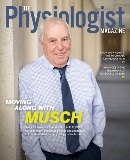John Williams, MD, PhD, FAPS, is emeritus professor and former chair of molecular and integrative physiology at the University of Michigan Medical School in Ann Arbor and a past APS president. Prior to retiring in 2022, he was a biomedical scientist whose research focused on the exocrine pancreas and its function. He recently published his memoir, “The Pancreas and Me: My Life as a Biomedical Scientist.” The Physiologist Magazine caught up with Williams to talk about his memoir, career and advice for up-and-coming researchers.
Writing a memoir is relatively uncommon for biomedical scientists. What drove you to write your memoir?
In 2021, my lab was getting ready to close, and I had just completed editing two multi-authored books, “Pancreatitis” and “The Pancreas: Biology and Physiology.” I was looking for a new writing project and realized that my career had spanned many changes in research and teaching that I could cover as a student, a professor and a department chair. I had to settle on a target audience. This started with my family, the scientists who had worked in my laboratory, and other academic colleagues and administrators. I chose to intersperse sections on my personal and academic lives and keep the science in separate sections with the focus on those who had carried out the research. I discussed the concept for the book with Charles Watkinson, the head of Michigan Publishing, and he encouraged me to continue and told me about Maize Books, a newer imprint of Michigan Publishing, which he felt would be a good fit. I also had many relevant photos that could serve as illustrations.
Your book is available through open access. What does that mean, and how did it work for you?
 Open access books
are being experimented with, especially by university publishers. The University of Michigan has developed a platform, Fulcrum, where Maize Books are mounted and can be freely accessed by anyone. Fulcrum supports multiple readers, as well as allowing
PDF downloads. Paperbound copies of the book are sold as usual, and my book is available from the University of Chicago Press and Amazon. Michigan Publishing arranged copy editing and typesetting and helped design the book cover. To help cover the costs,
I had to pay a subvention, which works similar to page charges for a journal article to keep the price reasonable and get it into the hands of as many readers as possible.
Open access books
are being experimented with, especially by university publishers. The University of Michigan has developed a platform, Fulcrum, where Maize Books are mounted and can be freely accessed by anyone. Fulcrum supports multiple readers, as well as allowing
PDF downloads. Paperbound copies of the book are sold as usual, and my book is available from the University of Chicago Press and Amazon. Michigan Publishing arranged copy editing and typesetting and helped design the book cover. To help cover the costs,
I had to pay a subvention, which works similar to page charges for a journal article to keep the price reasonable and get it into the hands of as many readers as possible.
What drew you to your main area of research, the pancreas?
My initial research was on the electrophysiology of the thyroid gland, a project suggested by my PhD adviser, J. Walter Woodbury at the University of Washington. However, I realized that most endocrine glands secrete peptide hormones packaged in secretory granules. While carrying out a postdoctoral fellowship with Keith Matthews at the University of Cambridge, I was introduced to the exocrine pancreas. It secretes digestive enzymes, and George Palade and colleagues had carried out beautiful research on pancreatic acinar cells that became part of the foundation for the new field of cell biology. Little was known about the control mechanisms that turned on and regulated secretion. I collaborated with several others, including Ole Peterson in the Matthews lab, to show that calcium ion released from intracellular stores stimulated secretion.
When I moved to UCSF as an assistant professor of physiology, studies of the exocrine pancreas took over the focus of my laboratory. While we continued studies of intracellular calcium, we extended the work to receptors on the cell membrane, and with a colleague, Ira Goldfine, we began working on regulation of the exocrine pancreas by insulin from the Islets of Langerhans. By this time, I had become a leader in the gastrointestinal (GI) research community, was teaching GI science, and was invited to be the second editor of the American Journal of Physiology-Gastrointestinal and Liver Physiology.
How important was teaching to you, and how has it changed during your 60-year career?
Teaching has always been an important part of my life. I learned by observing my teachers and from tutoring classmates in college and medical school. My early goal was to be direct and logical. I emphasized having clear illustrations. With experience, I realized that I needed to add humor whenever possible.
My classroom teaching primarily involved medical students, with some effort devoted to graduate students. My main teaching, however, was in the laboratory, teaching learners at multiple levels how to carry out research. The major changes in teaching during my 60 years have been how it was organized and the technology used to present it. When I started at the University of Washington, distinct classes covered different disciplines. Over time, knowledge was integrated into functional blocks with my area being the gastrointestinal system.
Technologically, I went from writing with felt pens on acetate sheets projected on a screen, to 35mm color slides, to projecting digital files that the students follow on a laptop or iPad. Lectures are also recorded, and many students stream rather than come to class. For more on this area, see my opinion piece published in Advances in Physiology Education, “Sixty years of learning and teaching physiology.”
Was maintaining work-life balance a challenge?
Yes. One of my biggest challenges was finding the time to spend with my family. Sometimes this was pointed out by family members, as when my son Matt complained about me being gone on his birthday. He was not happy with my explanation that I could not control the timing of the Federation of American Societies for Experimental Biology meeting scheduled in early April. I prioritized family on weekend outings, starting with toddlers in a backpack carrier and progressing to nature walks, camping, fishing and hiking. One important thing was family dinners with serious conversation every evening.
What’s your advice for preparing for a career in biomedical research?
First, being a biomedical scientist, or for that matter any type of scientist, is a great life. You get paid for engaging in your passion. The most important parts of PhD training are learning how to think analytically, to research a topic, and to communicate both orally and in writing. A PhD opens many doors even if you decide laboratory research is not for you. Within biomedical science, only a fraction of new PhDs will follow the path I took to become an academic scientist in a medical school. If this sounds like a well-polished spiel, it is one I tried to give to all PhD applicants visiting our department when I was chair.
This article was originally published in the January 2024 issue of The Physiologist Magazine. Copyright © 2024 by the American Physiological Society.
Exploring a Half-Century of Research Changes
 Linda Samuelson, PhD, FAPS, past APS president, has worked alongside John Williams, MD, PhD, FAPS, for more than 30 years at the University of Michigan.
Linda Samuelson, PhD, FAPS, past APS president, has worked alongside John Williams, MD, PhD, FAPS, for more than 30 years at the University of Michigan.
“I joined the Society when I was an assistant professor, and it was largely because John advised me to,” Samuelson says. “John has been an important mentor for me, and I’m currently the John A. Williams Collegiate Professor of Gastrointestinal Physiology, which reflects his important role for me in advancing my career.”
Samuelson says Williams’ influence through his mentorship, research, teaching and leadership has been enormous. “His memoir is not only the story of a highly successful physiologist, but it is also a fantastic way to appreciate the enormous changes that have taken place in biomedical research over the past 50 years,” she says.
The Physiologist Magazine
Read the Latest Issue
Don’t miss out on the latest topics in science and research.
View the Issue Archive
Catch up on all the issues of The Physiologist Magazine.
Contact Us
For questions, comments or to share your story ideas, email us or call 301.634.7314.


